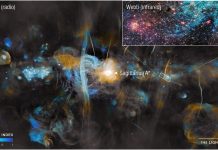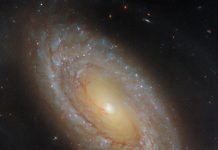During the 1980s, geography scientists found a remarkable revelation, they identified two massive, continent-sized masses of distinct material deep within the Earth’s core
These peculiar structures, within the Earth’s core, were located beneath the African continent and the Pacific Ocean, each approximately twice the size of the Moon. They likely contain different elemental compositions compared to the surrounding mantle.
Discovery of LLVPs
A recent study led by researchers from Caltech has put forth an intriguing explanation for the origins of the enigmatic blobs known as large low-velocity provinces (LLVPs). According to their findings, these LLVPs might have their roots in a tumultuous event that transpired billions of years ago when an ancient planet collided with Earth in a colossal impact, which also gave birth to our Moon.
This research offers a possible solution to another long-standing puzzle in planetary science. For years, scientists have speculated that the Moon emerged from a colossal collision between Earth and a smaller celestial body known as Theia. However, no tangible evidence of Theia has ever been discovered in the asteroid belt or meteorites. The new study suggests that most Theia was assimilated into the young Earth, eventually forming the LLVPs, while the remaining debris from the impact coalesced to create the Moon.
The giant-impact
The investigation was led by Qian Yuan, an O.K. Earl Postdoctoral Scholar Research Associate, in collaboration with the laboratories of Paul Asimow, the Eleanor and John R. McMillan Professor of Geology and Geochemistry, and Michael Gurnis, the John E. And Hazel S. Smits Professor of Geophysics and Clarence R. Allen Leadership Chair. Gurnis is also the director of Caltech’s Seismological Laboratory and oversees the Schmidt Academy for Software Engineering at Caltech.
The LLVP formation process
The discovery of the LLVPs was initiated by analysing seismic waves as they propagated through the Earth. Seismic waves exhibit varying speeds when traversing different materials, and during the 1980s, initial indications emerged of substantial three-dimensional irregularities deep within the Earth’s internal structure. In the deepest part of the mantle, the seismic wave patterns predominantly display the characteristics of two significant structures near the Earth’s core.
Scientists speculated that these structures hold an unusually high iron content, making them denser than their surroundings. This elevated density causes a deceleration of seismic waves passing through these regions, which led to the term “large low-velocity provinces.”
Scientists speculated that these structures hold an unusually high iron content, making them denser than their surroundings.
In 2019, Qian, who has a background in geophysics, participated in a seminar on the subject of planet formation. Mikhail Zolotov, a professor at Arizona State University, discussed the giant-impact hypothesis, while Qian observed that the Moon contains a notable amount of iron. Zolotov further mentioned that there was a lack of any evidence or indication regarding the celestial body that had supposedly collided with Earth in this context.
Yuan collaborated with a diverse team of experts from various fields to simulate scenarios involving Theia’s chemical composition and its collision with Earth. Through these simulations, they verified that the impact dynamics had the potential to give rise to both the LLVPs and the Moon.
A portion of Theia’s mantle could have merged with Earth’s mantle, subsequently aggregating and solidifying into the two unique structures currently observable at the Earth’s core-mantle boundary. Meanwhile, other remnants from the collision combined to for the moon.
the impact dynamics had the potential to give rise to both the LLVPs and the Moon.
Why did Theia’s material form blobs after the violent impact instead of mixing with Earth’s material?
The simulations showed that most of Theia’s impact energy stayed in the upper mantle, leaving the lower mantle cooler than previously thought. This allowed the iron-rich material from Theia to remain mostly intact as it sank to the base of the mantle like colours in a lava lamp settling when it was turned off.
Further research will explore how Theia’s material in Earth’s deep layers may have influenced processes like plate tectonics.











